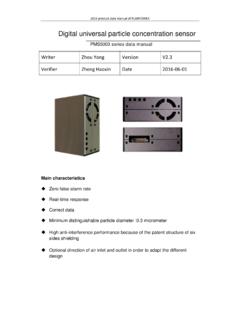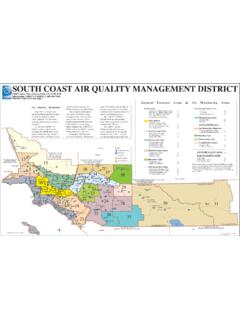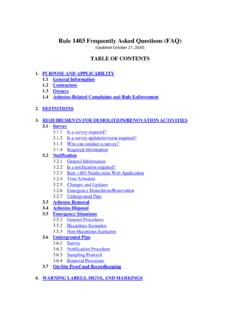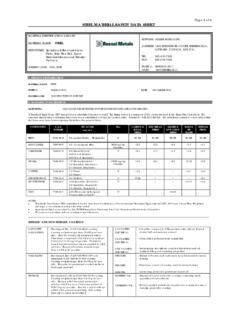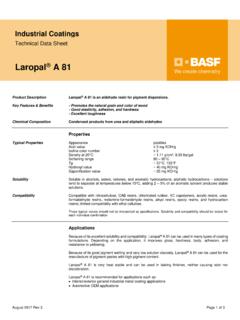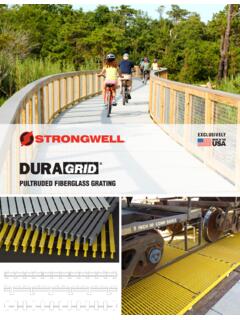Transcription of Guidelines for Calculating Emissions from Polyester Resin ...
1 Polyester Resin Operations (December 2019) - 1 - Guidelines for Calculating Emissions from Polyester Resin Operations (December 2019) The purpose of this document is to provide operators with Guidelines in estimating volatile organic compound (VOC) Emissions from the use of materials in Polyester Resin operations subject to District Rule 1162. The methodologies used in this document are consistent with 40 CFR Part 63, subpart WWWW. Starting with Fiscal Year 1999-2000, operators of Polyester Resin operations that are subject to Rule 1162 must use the methodologies in this guideline for Calculating and reporting VOC Emissions in the District Annual Emissions Reporting (AER) Program. In addition to the definition of terms in Rule 1162, the first section of this document describes the types of Polyester Resin operations that may be encountered.
2 The next two sections discuss the air Emissions associated with Polyester Resin operations and the use of emission factors and equations. The last section provides instructions and examples of how VOC Emissions are calculated and reported in the AER. DESCRIPTION OF OPERATIONS Atomized Mechanical Application means application of Resin or gel coat with spray equipment that separates the liquid into a fine mist. This fine mist may be created by forcing the liquid under high pressure through an elliptical orifice, bombarding a liquid stream with directed air jets, or a combination of these techniques. This process allows for a greater production rate and more uniform parts than hand lay-up. Closed Molding means a grouping of processes for fabricating composites in a way that VOC containing materials are not exposed to the atmosphere except during the material loading stage.
3 Processes where the mold is covered with plastic prior to Resin application, and the Resin is injected into the covered mold are also considered closed molding. Compression Molding means a closed molding process for fabricating composites in which composite materials are places inside matched dies that are used to cure the materials under heat and pressure without exposure to the atmosphere. Covered-Cure refers to an impervious film or barrier that is applied to the wet surface of the mold just after the application of the Resin . This barrier may be applied immediately after roll-out phase, or just after the application phase without any subsequent roll-out. Filament Application means an open molding process for fabricating composites in which reinforcements are fed through a Resin bath and wound onto a rotating mandrel.
4 The materials on the mandrel may be rolled out or worked by using non-mechanical tools prior to curing. Resin application to the reinforcement on the mandrel by means other than the Resin bath, such as spray guns, pressure-fed rollers, flow coaters, or brushes are not considered filament application. Fluid Impingement Technology means a spray gun that produces an expanding non-misting curtain of liquid by the impingement of low-pressure uninterrupted liquid stream. Polyester Resin Operations (December 2019) - 2 - Gel Coat is a specialized Polyester quick-setting Resin that is formulated to provide a cosmetic outer surface and to improve performance of the composite products. The solvent in gel coat is styrene monomer and/or methyl methacrylate (acrylic MMA) which cross-links during curing.
5 Hand Lay-Up is the simplest fabrication in open mold process. Hand lay-up is a manual application technique of composite materials using a bucket and a brush or a roller, or other hand held method of application. Hand lay-up uses no mechanical spraying or chopping equipment for depositing the Resin or glass reinforcement. The process continues until the desired thickness is achieved. The use of pressure-fed rollers and flow coaters to apply Resin is not considered manual Resin application. Injection Molding means a closed molding process for fabricating composites in which composite materials are injected under pressure into a heated mold cavity that represents the exact shape of the product. The composite materials are cured in the heated mold cavity. Methyl Methacrylate (MMA) is sometimes present as a secondary monomer added to the gel coat formulation to increase the UV-resistance, to improve the surface finish, and to impart greater toughness.
6 The greater vapor pressure of MMA makes it much more volatile than styrene. Its Emissions must be estimated separately from styrene Emissions . Non-Atomized Mechanical Application means the use of application tools other than buckets and brushes to apply Resin and gel coat. Examples of non-atomized application include flow coaters, pressure-fed rollers, and fluid impingement spray guns. Open Molding is a method of fabricating composite parts by applying gel coats, resins, fibers, and other composites materials on an open mold using either hand lay-up or spray-up applications. Polymer (Marble) Casting means a process for fabricating composites in which composite materials are ejected from a casting machine or poured into an open, partially open, or closed mold and cured. After the composite materials are poured into the mold, they are not rolled out or worked while the mold is open, except for smoothing the material and/or vibrating the mold to remove bubbles.
7 Pultrusion means a continuous process for manufacturing composites that have a uniform cross-sectional shape. The process consists of pulling a fiber-reinforcing material through a Resin impregnation chamber or bath and through a shaping die, where the Resin is subsequently cured. Robotic/Automated Spray means application of Resin or gel coat with atomized mechanical equipment in a controlled setting either robotically and/or automatically. Tooling Resin means a Resin that is used to produce molds. Tool resins generally have high heat distortion temperatures, low shrinkage, high hardness, and high dimensional stability. Vapor Suppressant (VS) means an additive, typically a wax, which migrates to the surface of the Resin during curing and forms a barrier to seal in the styrene and reduce styrene Emissions .
8 Vapor Suppressed Efficiency (VSE) means the percent reduction of styrene Emissions from the use of a Resin containing a vapor suppressant added for the purpose of reducing styrene Emissions during curing. VOC Emissions VOC Emissions from Polyester Resin operations occur when the cross-linking agent (monomer) contained in the liquid Resin evaporated from fresh Resin surfaces into air during application curing. Polyester Resin Operations (December 2019) - 3 - VOC Emissions also come from the use of solvents for clean-up of hands, tools, molds, and application equipment. Styrene and methyl methacrylate are by far the principle and the most common monomers used in cross linking agents. Since Emissions result from evaporation of monomer from the uncured Resin , they depend upon the amount of Resin surface exposed to the air and the duration of exposure.
9 Thus the potential for Emissions varies with the manner in which the Resin is mixed, applied, handled, and cured among the different fabrication processes. For example, the spray lay-up operation has highest potential for VOC Emissions because the atomization of Resin into spray creates an extremely large surface area from which volatile monomer can evaporate. In contrast, the emission potential in synthetic marble casting and closed molding operations is considerably lower, because of the lower monomer content in the casting resins and of the enclosed nature of the moldings. VOC Emissions from Polyester Resin operations can be reduced by the implementing the following: Switch to low VOC emitting application method; Improve Resin transfer efficiency; Reduce styrene content in Resin or use catalyzed Resin ; Use vapor suppressed resins; or Use add-on controls.
10 EMISSION FACTORS The Emissions from the Polyester Resin operations can be calculated using the factors provided in the attached tables and the following equation. Emission = Throughput x Emission Factor Equation 1 The unit for annual throughput must be consistent with the unit of emission factor. For styrene and MMA Emissions from Polyester Resin operations, the emission factors are determined using styrene and/or MMA contents in the resins and equations in Tables 2 or 3. Operators are encouraged to calculate Emissions from the process using specific parameters that are applicable to its operations. Supporting documents must be submitted with the annual emission report to show the use of such parameters in Calculating annual Emissions . In addition to Emissions from the monomers (styrene and/or MMA), Emissions from other VOC solvents, commonly MEK, in the Resin must also be calculated separately and combined with Emissions from styrene and/or MMA.
